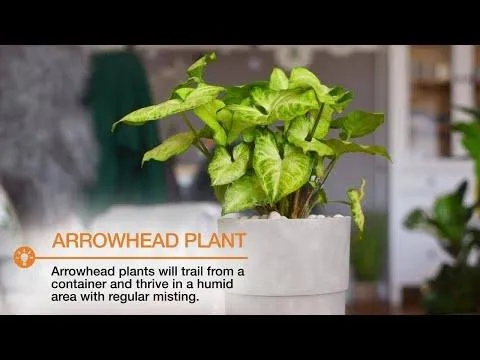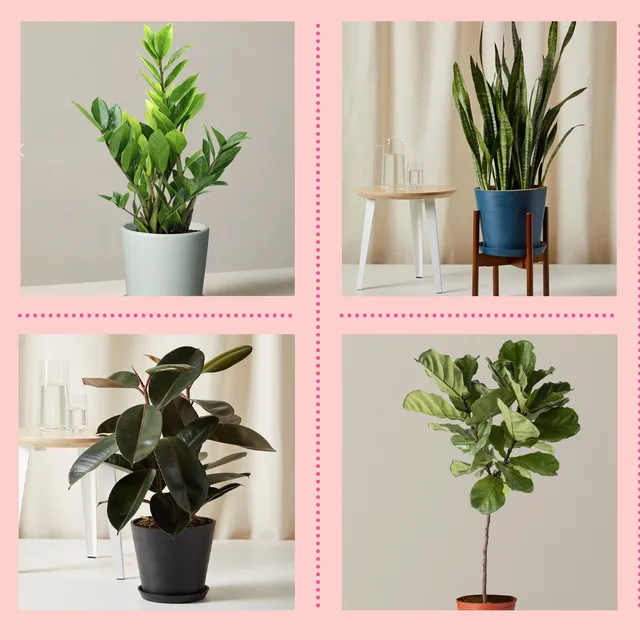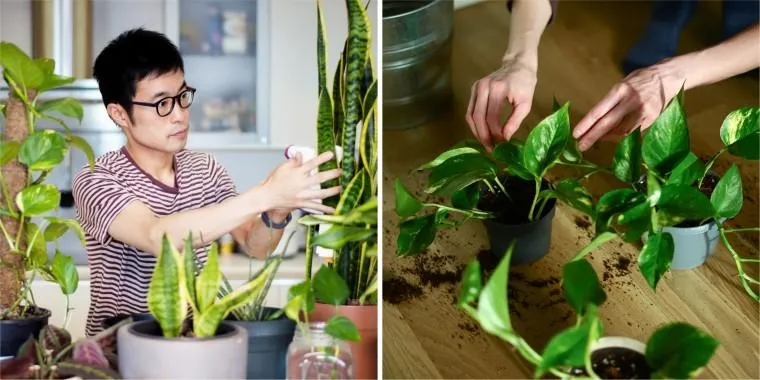The Best Trees for Growing Inside Your Home
If you’re looking for the simplest trees to cultivate within the comforts of your home, look no further. In this comprehensive guide, I’ll explore the top options for easy indoor trees and answer all the questions a curious grower might have. From light and watering requirements to ideal locations, care tips, and more – by the end you’ll know exactly which trees are best suited for the indoor gardener in you.
Golden Pothos
- Scientific Name: Epipremnum aureum
- Growth Type: Evergreen trailing vine
- Hardiness: USDA Zones 10b-11 (houseplants)
Golden Pothos is arguably the easiest houseplant you can grow. From my own experience, it’s practically impossible to kill! It thrives in low to medium light conditions like offices or bedrooms. The soil only needs watering when mostly dry. Pothos removes toxins from indoor air, making it a great choice for air quality. Simply prune and propagate cuttings to create a fuller plant. Try training it up a moss pole for a beautiful hanging effect.
Snake Plant
- Scientific Name: Sansevieria trifasciata
- Growth Type: Evergreen succulent
- Hardiness: USDA Zones 9-11 (houseplant)
Nicknamed “Mother-in-Law’s Tongue”, Snake Plant needs only occasional water and tolerates low light well. I find it survives prolonged neglect better than most! It thrives in offices, bathrooms – really anywhere. Snake Plant releases oxygen at night and removes common indoor toxins like formaldehyde from the air. Simply trim off pups or flower stalks for propagation. Despite needing little care, it adds drama and texture to any space.
Chinese Evergreen
- Scientific Name: Aglaonema species
- Growth Type: Evergreen perennial
- Hardiness: USDA Zones 10-11 (houseplant)
Chinese Evergreen comes in a rainbow of stunning colored leaves. In my experience, it grows vigorously even in low light. The soil can stay moist but should never sit in water – this plant seems to basically care for itself! It’s quite unfussy as long as you provide average indoor conditions. With its decorative foliage and low maintenance needs, Chinese Evergreen brings botanical beauty wherever you place it. Simply trim off any damaged leaves to tidy it up.
Peace Lily
- Scientific Name: Spathiphyllum species
- Growth Type: Evergreen perennial
- Hardiness: USDA Zones 9-11 (houseplant)
Peace Lily earned its name by producing beautiful white flowers that seem to bloom in response to stress! In reality, the plant simply signals when it needs water by drooping its leaves. Water thoroughly when the soil is dry and the leaves droop – they’ll perk right back up. Peace Lily thrives in low to medium light, making it ideal for areas like bathrooms. It removes common indoor air pollutants too. Simply divide or transplant pups for propagation. Peace Lily adds delicate grace to any indoor space.

By now you’re probably wondering – how do I care for my new houseplant? Below are some general indoor tree care tips to keep in mind:
Watering
When the top inch or two of soil is dry, water thoroughly until water drains from the drainage holes. Feel free to err on the slightly drier side, as overwatering causes more issues than underwatering. Use room temperature water and never let plants sit in water.
Light
Most of the options above thrive in medium to low indirect light. Put them near an east or west-facing window. Rotate plants regularly for even growth. Consider supplementing with grow lights in darker spots.
Fertilizing
During the active growing season (spring-summer), use a diluted liquid houseplant fertilizer every few weeks. Insect infestations or deficiency symptoms are signs to reduce or increase fertilizer accordingly.
Pruning
Snip off any dead, diseased or damaged growth to keep plants looking their best. You can also trim plants to control their shape and size or propagate cuttings for new plants.

Repotting
Repot plants pot-bound or noticeably rootbound, usually every 1-2 years in the spring. Use a well-draining potting mix and remove any rotted roots.
Pests
Check regularly for pests like spider mites, scale or mealybugs. Treat immediately with neem oil or insecticidal soap if spotted to avoid infestation. Prevention through quarantine of new plants is key here.
Environment
Houseplants prefer average indoor temperatures around 65-80°F. Provide adequate humidity around 50% with a pebble tray or humidifier if needed. Rotate plants to encourage even growth.
Now that you know the easiest trees to grow indoors, plus their care needs, I hope you’ve found the perfect plant to start your new indoor gardening hobby. Go out and pick one up today – it’s basically impossible to mess up caring for these low-maintenance beauties. Let me know if you have any other plant questions!
Easiest Trees to Grow Indoors
| Tree | Care Level | Growth Rate | Height | Light Needs |
|---|---|---|---|---|
| Snake Plant | Very Low | Slow | Up to 3 feet | Low |
| Chinese Evergreen | Low | Moderate | Up to 6 feet | Medium |
| Peace Lily | Low | Moderate | Up to 3 feet | Medium |
| Golden Pothos | Very Low | Fast | Unlimited as vine | Low |
| AZALEA | Low | Moderate | Up to 4 feet | Medium |
FAQ
-
What type of tree grows well indoors?
Bonsai trees, dwarf fruit trees, and flowering trees like hibiscus and jasmine do well in pots indoors. They need less space and don’t get too large. Basically any small tree that doesn’t need a ton of soil or sunlight should do okay inside.

-
Which variety of tree has the best chance of survival indoors?
Dwarf varieties of citrus trees, like Meyer lemon and kumquat, generally do well in pots. They don’t take up much room and give you the joy of growing something you can eat! Peace lilies and dwarf date palms also seem to bounce back from the typical mistakes of indoor gardening better than other trees. So if you “kind of” kill your first indoor tree, those might be more forgiving replacements.
-
What care does an indoor tree need?
Indoor trees need consistent water and drainage. The soil should never stay soggy or totally dry out. You also need to provide adequate light. A south-facing window is best. During the darker months, a grow light helps. At the same time, watch for pests and remove any diseased foliage. Regular pruning keeps trees neat and shapes their growth. With the right care, indoor trees can thrive for years!
-
How do I know if a tree is getting enough sunlight inside?
Check the color of its leaves. Trees getting plenty of light will have a darker green foliage, while light-starved leaves will look pale or yellow. You can also examine new growth. Branches that are reaching or stretching a lot probably need more sunlight. But is it really possible to give a tree “enough” light indoors? Sometimes trees just “sort of” have to put up with subpar indoor conditions.
-
What kinds of pests couldinfect my indoor tree?
The most common indoor tree pests are spider mites, scale, and aphids. Spider mites spin tiny webs on leaves and can totally defoliate an oak tree within weeks. Scale looks like little bumps or shells on branches. Mealybugs are sort of fluffy masses that hide in leaf joints. You’ll want to closely inspect your tree regularly for any signs of infestation. Neem oil, insecticidal soap, and horticultural oil sprays help control these common pests when used as directed. But the threat of creepy-crawlies is ever-present with indoor trees, unfortunately!
-
How do I transplant a tree that has outgrown its pot?
When spring temps rise, you can take your potted tree outside and tip it on its side. Tap the bottom to loosen the rootball from the edges and lift it out. Untangle the roots if needed and use your hands to gently separate and spread them out in the new, larger container. Fill in around the edges with fresh potting soil. Add water until it drains out the bottom holes. Bring it back inside and keep the soil moist until new growth appears. With any luck, your tree will love its new “digs” – if you can call a pot digs!

-
What trees are definitely not suited to growing indoors?
Large shade trees like oaks, elms, and maples need way bigger pots than are practical for home use. They also demand more intense light than is possible without immense grow-light setups. Conifers often fare poorly in warm, dry indoor air too. At the same time, citrus trees begin to outgrow typical household conditions after a few years and eventually want outdoor space. So fast-growing trees and anything lacking adaptations to pots are best left for outdoor landscape use, sadly.
